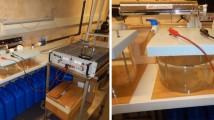Abstract
This paper deals with a new anti-fouling method by hydrogen peroxide with ferrous ion for a marine cooling water system. Emphasis is on macrofouling which decreased less than 10% of the amount of the control after the chemical treatment of seawater. The duration of the chemical effectiveness was examined with 60-m unheated model channels from April to July 1986. Since hydrogen peroxide and ferrous ion were reduced by 20% and 40%, respectively, within 10 min, the retention period of seawater in the system is necessary to extrapolate test results from pilot studies to actual application. It is suggested that the active oxygen radical produced in seawater from the reaction of hydrogen peroxide with ferrous ion, affects attachment and subsequent growth of sedentary larvae of marine animals. The results indicated that for barnacles, the chemicals did not disturb the settling behavior of the cyprid, but inhibited the growth of the young after settling. For mussels, on the other hand, which were collected offshore of Tokushima Prefecture from March to June 1986, the chemicals hampered the pelagic pediveliger or plantigrade substantially during the exploratory phase.
Similar content being viewed by others

Literature cited
Baalen, C. Van., Warler, J. E. (1966). Occurrence of hydrogen peroxide in seawater. Nature, Lond. 211: 951
Bayne, B. L. (1976). Marine mussels: their ecology and physiology. Cambridge University Press, Cambridge
Bean, R. M., Neitzel, D. A., Thomas, B. L. (1984). Analysis of sediment and suspended matter for halogenated products from chlorination of power plant cooling water. US DOE Rep. (USA) (PNL-SA-11927)
Chiba, K. (1986). Fish and plankton not damaged by hydrogen peroxide and ferrous ion. In: Research report on the application of anti-fouling reagent. National Federation of Fisheries Cooperative Associations, Japan (available from author on request)
Cooper, W. J., Zika, R. G. (1983). Photochemical formation of hydrogen peroxide in surface and ground water exposed to sunlight. Science, N.Y. 220: 711–712
Crisp, D. J. (1976). Settlement responses in marine organisms. In: Newel, R. C. (ed.) Adaptation to environment: essays on the physiology of marine animals. Butterworth and Co (Publishers) Ltd, London, p. 83–124
Haag, W. R., Hoigne, J. (1984). Kinetics and products of the reaction of ozone with various forms of chlorine and bromine in water. Ozone 6 (2): 103–114
Halliwell, B., Gutteridge, J. M. C. (1984). Oxygen toxicity, oxygen radicals, transition metals and disease. Biochem. J. 219: 1–14
Helz, G. R., Kosak-Channing, L. (1980). Chlorine alternatives: Rcaction of O3, H2O2 and BrCl with inorganic components of seawater. Department of Chemistry, University of Maryland, Maryland, USA PB 81-205379
Ishihara, F., Saitoh, H. (1984). The results of chemical analysis on T. H. M. in seawater added hydrogen peroxide. Research report of Mitsubishi Gas Chemical Company Inc. (available from author on request)
Katayama Chemical Inc. (1985). Process for preventing growth of marine organisms. Japanese unexamined patent application laid open to publication. No. sho-60-106584
Matsuoka, M., Ohnishi, K., Araki, S., Shibaori, I. (1984). Environmental investigation of nursery; change of seawater condition at nursery Kitanada (Naruto City) and Uchinoumi. Res. Bull. Tokushima prefect. Fish. exp. Stn: 75–80
Mitsubishi Gas Chemical Company Inc. (1982). Process for preventing growth of marine organisms on a substance using hydrogen peroxide. U.S. Patent No. 4,324,784
Nagae, O., Akizuki, T. (1982). Environmental investigation of nursery XI-2 characteristic of seawater condition at nursery Uchinoumi. Res. Bull. Tokushima prefect. Fish. exp. Stn: 84–87
Nagae, O., Akizuki, T. (1983). Environmental investigation of nursery XII-2 characteristic of seawater condition at nursery Uchinoumi. Res. Bull. Tokushima prefect. Fish. exp. Stn: 134–137
Nakayama, S., Tanaka, M., Yamauchi, S., Tabata, N. (1981). Preventing system of bio-fouling in pipe line by short time shock dosing of ozone. P P M 12 (10): 14–27
Tanaka, J. (1978). Influence of agricultural chemicals on water organisms. Volume of acute toxicity data. Scientist Inc., Tokyo, Japan.
Wakao, Y., Ichikawa, S. (1986). Test results on settlement season of marine mussels at Naruto (Uchinoumi), Tokushima, Japan (available from author on request)
Watanabe, I. (1985). Effects of bromide ions on production of halogenated phenols in water chlorination. Proc. Osaka prefect. Inst. Publ. Health 23: 121–128
Yoshizumi K., Aoki, K., Nouchi, I., Okita, T., Kobayashi, T., Kamakura, S., Tajima. M. (1984). Measurements of the concentration in rainwater and of the Henry's law constant of hydrogen peroxide. Atmos. Environ. 18 (2): 395–401
Author information
Authors and Affiliations
Additional information
Communicated by M. Anraku, Tokyo
Rights and permissions
About this article
Cite this article
Nishimura, K., Yasunaga, T., Ichikawa, S. et al. Development of a new antifouling method for a marine cooling water system. Mar. Biol. 99, 145–150 (1988). https://doi.org/10.1007/BF00644989
Accepted:
Issue Date:
DOI: https://doi.org/10.1007/BF00644989



